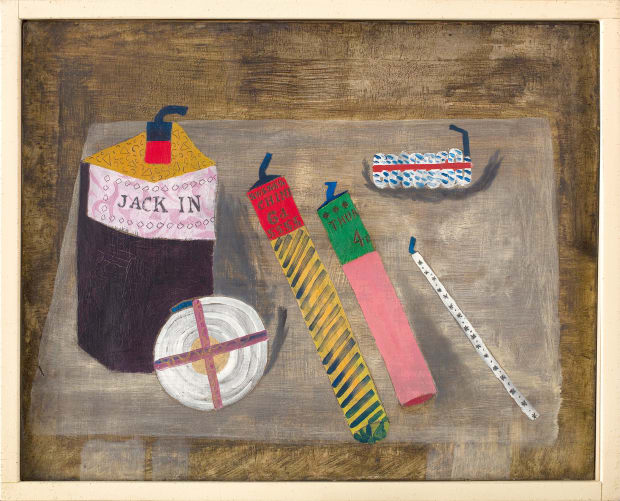-

Between 1929 and 1954, Ben Nicholson (1894–1982) underwent a series of creative transformations. This display brings together four paintings and a painted relief that represent the key themes in his work through these years: the heavy scraping, gay colour and unconventional still-life subjects of the twenties; the breakthrough into carving in December 1933, marked here by the inclusion of his first completed relief; the purified geometry and colour schemes of non-representational work made between 1935 and 1945; and the joyous rediscovery of table-top still life after World War II.
Nicholson’s transformations are explained in part by changing relationships. His interests shifted as he moved from the company of Christopher Wood, Alfred Wallis and his first wife Winifred Nicholson to the milieu of avant-garde Paris with his second wife Barbara Hepworth, where he met Piet Mondrian and others. But overwhelmingly, as Nicholson himself often said, his personal development was driven by a continuous sustained application to his own work, advancing ‘from experiment to experiment’, as the critic Herbert Read wrote in 1948.
Nicholson came of age before ‘abstract art’ was an idée fixe, and this enabled him to work freely between imitative and non-imitative idioms. His constructivist language, using clearly outlined shapes and monotone panels of colour, sometimes suggested external referents—a circle might evoke the moon, a hole, a ball—while the richly illusionistic spatial qualities in his still life pictures, produced by multiple overlapping perspectives, are complemented by palpably material constructions, including scraped glue-based grounds and paint surfaces scored with ruled pencil lines. Together the five works on display here demonstrate the qualities of wit and invention that set Nicholson among the foremost modernist artists of his generation. -

-
Although ‘[t]he subject matter of “fireworks” came first to Kit Wood’, as Nicholson told Charles Harrison in 1969, it was in Nicholson’s paintings that they became a focal point. The table top in 1929 (Guy Fawkes) is filled with these gaily coloured objects. They are represented frontally even as the table itself is foreshortened: single-point perspective is eschewed and these multiple perspectives overlap to produce an engaging pictorial tension.
Each firework—circular, rectangular—has a sharp and shapely silhouette. Their colours—pink, green, yellow, red, blue—suggest the colourful explosions of a detonated firework. The decorative patterns of the packaging—asterisks, spots, stripes—are directly handled: some are scraped into the paint surface in outline; others are painted in a repetitive motif of flat brushstrokes. Nicholson’s treatment of fireworks also notably introduces lettering, which is playful, calligraphic and overtly cubist in its field of reference.
-

-
December 1933 (first completed relief), previously known as ‘Two Circles’, is a canonical artwork in the history of European modernist art. Ben Nicholson’s reliefs of the nineteen-thirties are among his foremost contributions to the Modernist movement, and this work belongs near the beginning of a sequence of stylistic progression that led rapidly to the white reliefs of 1934. It was made in a period of acute discovery in which personal and artistic breakthroughs were inseparable, with his burgeoning relationship with the sculptor Barbara Hepworth encouraging the development of depth and tactility in his own work.
-

-
Design for an Act Drop belongs to a decade-long phase of Ben Nicholson’s career between 1935 and 1945 in which he made abstract paintings and low reliefs, distinguished by a personal combination of rectilinear shapes and intense local colour. Shortly after he began to make rough-hewn relief carvings in December 1933, he progressed rapidly to more refined and rectilinear carvings in low relief, and then to painted reliefs in 1939. All the while, from as early as 1935, he made entirely flat planar paintings, which closely resembled the appearance of his carved reliefs. Design for an Act Drop is an example of Nicholson using in two dimensions the idiom he had developed in three.
-

-
The composition of July 14–54 (viper) employs the cubist conceit of multiple overlapping perspectives. The rectangle of the table top is pictured squarely, as if from above, and the still-life arrangement is viewed frontally. A further conceit, employed frequently by Nicholson, is to treat the still-life vessels as if they were transparent, thereby allowing the silhouette of each object to remain visible and causing those objects behind to be viewed with equal clarity to those at the front. By treating vessels as transparent, Nicholson gave full expression to his fluent style of draughtsmanship. Continuous free-flowing pencil lines came to overlap and interconnect as he superimposed the images of individual glasses, cups and jugs one upon another.
-
Ben Nicholson
December 1933 (first completed relief)
Past viewing_room




